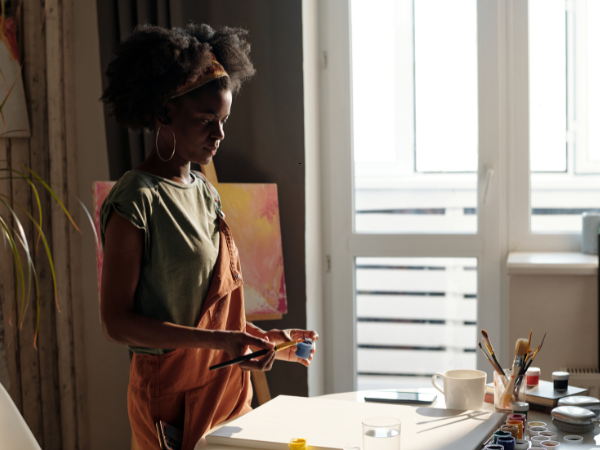You’ll discover how artists, famous art shows, and timeless masterpieces can spark your creativity and help you make your own unique art journal. Whether you’re a beginner or someone looking to refresh your artistic spirit, this guide will give you fresh ideas and simple ways to bring your journal to life.
Artist Inspirations
The Art Journal celebrates creativity by drawing inspiration from artists, shows, and masterpieces. Artist Inspirations form the heart of this journey. They reveal how artists influence each other across time and styles. This section explores three key groups shaping art today.
Modern Innovators
Modern innovators push boundaries and challenge old ideas. They use new materials, technology, and themes. Their art often reflects current life and social issues. These artists inspire with bold choices and fresh visions.
- Mixed media: Combining paint, digital art, and found objects.
- Digital art: Using software and virtual reality.
- Social themes: Exploring identity, environment, and politics.
Many modern artists work in urban spaces or online. Their work speaks directly to today’s audience. Here is a simple table showing some key traits:
| Trait | Description | Example Artist |
|---|---|---|
| Innovation | New methods and materials | Ai Weiwei |
| Engagement | Focus on society and culture | Kara Walker |
| Technology | Digital and interactive art | Refik Anadol |
Classic Masters
Classic masters laid the foundation of art as we know it. Their works show skill, balance, and storytelling. These artists followed rules but added personal style. Their paintings and sculptures remain valuable lessons.
Famous classic masters include Leonardo da Vinci, Rembrandt, and Michelangelo. They inspired many generations with:
- Technical mastery: Perfect use of light, shadow, and perspective.
- Human emotion: Expressing feelings through faces and gestures.
- Timeless themes: Love, nature, power, and faith.
Studying their work helps artists learn discipline and creativity. Classic art pieces often serve as references for training and inspiration. Here is a quick look at their impact:
| Master | Key Contribution | Famous Work |
|---|---|---|
| Leonardo da Vinci | Realism and anatomy | Mona Lisa |
| Rembrandt | Light and shadow | The Night Watch |
| Michelangelo | Sculpture and human form | David |
Emerging Voices
Emerging voices bring new energy and ideas to the art world. These artists are often young or less known but full of promise. They explore fresh topics and styles, reflecting today’s culture.
Many use art to tell personal or community stories. Their work often highlights diversity and change. Emerging artists connect with audiences through:
- Bold colors and abstract forms
- Experimental techniques and media
- Focus on social justice and identity
Art shows and galleries help these voices reach wider audiences. Support for emerging artists grows as their work gains recognition. Here is a simple list of what makes them unique:
- Innovative ideas
- Strong personal stories
- Connection to current events
Influential Art Shows
The world of art thrives not only through the works of individual artists but also through the powerful experiences created by art shows. Influential art shows bring together artists, collectors, and enthusiasts, sparking creativity and inspiring fresh ideas.
Iconic Exhibitions
Iconic exhibitions stand as milestones in art history. They gather groundbreaking works that challenge norms and push boundaries. These shows often define entire movements or highlight the genius of a single artist. Visitors leave with a new understanding of art’s possibilities.
Examples of famous exhibitions include:
- The Armory Show (1913) – Introduced modern art to America.
- Documenta (every 5 years since 1955) – Focuses on contemporary art from around the world.
- MoMA’s “The Family of Man” (1955) – Showcased photography as a universal language.
These exhibitions often feature:
| Feature | Impact |
|---|---|
| Curated Themes | Present clear artistic messages or social commentary |
| Rare Artworks | Display pieces not often seen by the public |
| Interactive Elements | Engage visitors deeply with the art |
Such exhibitions become sources of inspiration for artists and audiences alike. They create moments to reflect on culture, history, and human experience.
Global Art Fairs
Global art fairs serve as vital hubs for the art world. These events gather galleries, artists, and buyers from many countries. They offer a wide range of artworks, from emerging artists to established names. Visitors experience a snapshot of the current art scene worldwide.
Key features of global art fairs include:
- Diverse Artworks – Paintings, sculptures, photography, and mixed media.
- Networking Opportunities – Connect with artists, collectors, and curators.
- Educational Programs – Talks, workshops, and guided tours.
Popular global art fairs are:
- Art Basel – Held in Basel, Miami Beach, and Hong Kong.
- Frieze Art Fair – Takes place in London and New York.
- TEFAF – Known for fine art and antiques, based in Maastricht.
These fairs boost artists’ visibility and open markets internationally. They also attract collectors searching for unique pieces and new trends. For many visitors, art fairs offer a dynamic, inspiring experience that blends commerce and creativity.
Masterpieces That Move
The world of art holds countless masterpieces that touch the heart and stir the soul. Masterpieces That Move are those works that go beyond beauty. They tell stories, evoke emotions, and inspire new thoughts. These pieces capture moments in time and express feelings everyone can understand.
Timeless Paintings
Timeless paintings have a unique power. They speak across centuries and remain relevant today. These artworks show skill, imagination, and deep emotion. They often depict important moments, people, or ideas. Their colors and forms still attract eyes and hearts.
Some key features of timeless paintings include:
- Strong composition that guides the viewer’s eye.
- Expressive use of color to set mood and tone.
- Emotional depth that invites personal reflection.
- Symbolism that adds layers of meaning.
Here is a brief look at three famous timeless paintings:
| Painting | Artist | Year | Why It Moves Us |
|---|---|---|---|
| Mona Lisa | Leonardo da Vinci | 1503 | The mysterious smile and lifelike gaze intrigue viewers. |
| The Starry Night | Vincent van Gogh | 1889 | Swirling skies express deep emotion and turmoil. |
| Girl with a Pearl Earring | Johannes Vermeer | 1665 | The gaze and light create a moment frozen in time. |
These paintings continue to inspire artists and audiences. They show how art can capture the human spirit in a single frame.
Sculptural Wonders
Sculptural wonders bring art into three dimensions. They invite viewers to walk around and feel the shape. These works show the artist’s skill with form and space. Sculptures can be made from stone, metal, wood, or other materials.
Sculptures often express movement, strength, or delicate beauty. They transform solid materials into lifelike or abstract forms. This makes them powerful and moving.
Important aspects of sculptural wonders include:
- Use of space to create dynamic shapes.
- Texture and surface that engage touch and sight.
- Balance and weight to suggest motion or stillness.
- Interaction with light to highlight details.
Examples of famous sculptures that move us:
- David by Michelangelo: Shows human strength and beauty.
- The Thinker by Auguste Rodin: Captures deep thought and emotion.
- Venus de Milo: Embodies grace and mystery in classical form.
Sculptural wonders invite us to explore art from every angle. They remind us that art lives in space, not just on flat surfaces.
Creative Techniques
Creative techniques form the heart of artistic expression in The Art Journal: Inspiration from Artists, Shows, And Masterpieces. These techniques help artists bring ideas to life with unique styles and emotions.
Brushwork And Texture
Brushwork is more than just moving a brush on canvas. It shapes the mood and energy of a painting. Artists use various brush strokes to create different effects, from smooth blends to rough, bold marks. Each stroke adds personality and movement to the art.
Texture adds a three-dimensional feel to a painting. It can be soft and subtle or thick and dramatic. Artists achieve texture by:
- Using heavy paint layers (impasto)
- Mixing materials like sand or fabric into paint
- Applying paint with tools other than brushes, such as palette knives or sponges
Here is a simple table showing common brushwork styles and their effects:
| Brushwork Style | Effect | Example |
|---|---|---|
| Short, quick strokes | Creates energy and movement | Impressionist landscapes |
| Long, smooth strokes | Gives a calm and soft appearance | Realistic portraits |
| Thick, bold strokes | Adds texture and drama | Abstract art |
Texture invites viewers to feel the painting visually. It adds depth and interest, making art more engaging. Together, brushwork and texture show the artist’s hand and style clearly.
Color Theory In Practice
Color theory is the science and art of using colors well. It guides artists in mixing and pairing colors to create harmony or contrast. Good use of color can change how a painting feels and what it communicates.
Basic color concepts include:
- Primary Colors: Red, blue, yellow – cannot be made by mixing others.
- Secondary Colors: Green, orange, purple – made by mixing primary colors.
- Complementary Colors: Colors opposite on the color wheel, like red and green, create strong contrast.
Artists use these ideas to choose colors that work well together. Some common color schemes are:
- Monochromatic: Different shades of one color
- Analogous: Colors next to each other on the wheel
- Complementary: Opposite colors for bold contrast
Here is a simple color wheel to visualize these relationships:
| Primary | Secondary | Complementary Pair |
|---|---|---|
| Red | Orange | Red – Green |
| Blue | Green | Blue – Orange |
| Yellow | Purple | Yellow – Purple |
Color theory helps artists evoke emotions. Warm colors like red and yellow feel energetic. Cool colors like blue and green feel calm. Using these colors with care makes a painting more powerful and meaningful.
Incorporating Inspiration
Capturing inspiration from artists, shows, and masterpieces fuels creativity in an art journal. Incorporating inspiration helps transform fleeting ideas into lasting works. It creates a bridge between what you see and what you imagine. This process encourages exploration and personal growth.
Sketching Ideas
Sketching ideas is the first step to bring inspiration to life. Quick sketches capture moments and feelings before they fade. Use simple lines and shapes to express your thoughts fast. Sketching helps organize ideas and develop them further.
- Carry a small sketchbook. Draw anytime inspiration strikes.
- Use different tools. Pens, pencils, or markers add variety.
- Focus on shapes and forms. Don’t worry about details initially.
- Try thumbnail sketches. Small, quick drawings to plan compositions.
Sketches can be rough or detailed. The goal is to keep ideas visible and growing. Many artists use grids or simple tables to compare ideas:
| Sketch | Inspiration Source | Notes |
|---|---|---|
| Abstract shapes | Modern art exhibit | Focus on color contrast |
| Nature patterns | Botanical show | Use repeating lines |
| Portrait study | Masterpiece painting | Practice facial features |
Keep sketches loose and flexible. They are tools to unlock creativity, not final products. Revisiting and refining sketches helps reveal new possibilities. Each drawing adds value to your art journal and your art journey.
Developing Themes
Themes give your art journal structure and meaning. They connect individual sketches and ideas into a bigger story or message. Developing themes helps clarify what you want to express through your art.
Start by reviewing your sketches and notes. Look for common elements or emotions. Ask questions like:
- What feelings do these sketches evoke?
- Do certain colors or shapes repeat?
- Is there a story behind these images?
Use answers to identify a theme. Themes can be simple or complex. Examples include:
- Nature and growth
- Urban life and movement
- Light and shadow
- Emotion and memory
Write theme statements in your journal. Keep them brief and clear. For example:
“Exploring the calm and chaos in city life through bold lines and dark colors.”
Developing themes also guides your material choices and techniques. It helps keep your work focused. Themes make your art journal more meaningful and cohesive. They invite deeper reflection and connection with your audience.




